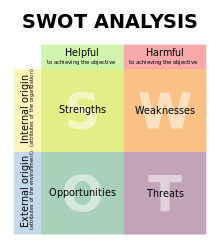Atlanta Metropolitan State College
Administration
SWOT Analysis
Definition of SWOT Analysis
SWOT stands for
- Strengths
- Weaknesses
- Opportunities
- Threats
SWOT analysis is a process used to establish the current state (baseline) of a unit or institution and provide a framwork to develop an effective strategy for improvemets. Strengths and weaknesses are internal characteristics that make up a unit. Opportunities and threats are external factors that influence quality and productivity. It is important to distinguish between internal and external components of SWOT. Internal aspects of SWOT (strengths and weaknesses) are those areas that can be controlled by the unit, whereas external aspects (opportunities and threats) of SWOT are those areas that the unit cannot control, but can impact. The following diagram demonstrates the differences.

SWOT Development and Data Collection
A SWOT analysis is data driven. It should not be created in a vacuum. Therefore, a unit should collect the following data to develop a SWOT analysis:
Strengths and Weaknesses
- Data types to develop strengths & weaknesses should include: (1) capabilities (areas of specialty or expertise of unit members), (2) Resources (fiscal, name brand, assets, and human), and (3) Processes (list and rate effectiveness and efficiency of processes, including communication, that the unit utilizes)
- Obtain Unit members and Customer Feedback (e.g. surveys, focus groups, interviews)
Opportunities and Threats
- Data types to develop opportunities and threats include those that define the external environment (e.g. employment, local economic demands, and industry ( (e.g. programs, placement rates, tuition, enrollment needs) for public and for-profit entities who provide competitive products/services. A collection and analysis of environmental data are called an environmental scan. This data is called secondary data because it is collected by someone other than the person utilizing the data.
- Obtain Environmental and Industry Feedback (e.g. employer surveys, focus groups, interviews, observations and interviews of peer institutions)
Use of the SWOT Analysis
The benefit of a SWOT analysis is to inform the improvement of quality and productivity of the organization or unit..
The purpose of a SWOT Analysis is to develop a strategy, or short-term and long-term goals and objectives, for improving a unit or organization. To develop ideas for strategies, strengths should be matched with opportunities and weaknesses to explore possibilities for improvement. Are there opportunities that off-set threats. These and questions below will assist in forming ideas and finally developing strategies for improvement.
(1) How can the unit take advantage of, capitalize, and leverage its strengths to address weaknesses and threats?
(2) How does the unit minimize the effect of and shore up its weaknesses?
(3) How can the unit invest in its opportunities?<br/>
(4) How can the unit deal effectively with its threats?